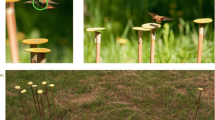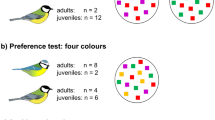Abstract
When animals make choices about food sources, potential mates or nest sites, they encounter options either simultaneously or sequentially. As human choices can be altered depending on whether they encounter options simultaneously or sequentially, it seems plausible that animal choices may also be influenced by the way in which they encounter options. Here, we examined whether birds’ choices were affected by the way in which they learned about possible options. In one treatment, we presented hummingbirds with each of three foraging options (5, 20 or 30 % sucrose solution) either sequentially or simultaneously before presenting birds with a choice of all three options simultaneously. When the birds had learned about options simultaneously, they had stronger preferences for the best option (30 %) than when they had learned about the options sequentially. These data are consistent with the stronger preferences for simultaneously encountered options in the mate choice literature. In both situations, it is possible that this effect comes about because it is easier to discriminate among multiple options presented simultaneously and/or because there are costs of failing to accept an option when those options are presented/encountered sequentially.


Similar content being viewed by others
References
Bacon I, Hurly TA, Healy SD (2011) Hummingbirds choose not to rely on good taste: information use during foraging. Behav Ecol 22:471–477
Barry KL, Holwell GI, Herberstein ME (2010) Multimodal mate assessment by male praying mantids in a sexually cannibalistic mating system. Anim Behav 79:1165–1172
Bateson M (2002) Context-dependent foraging choices in risk-sensitive starlings. Anim Behav 64:251–260
Bateson M, Healy SD (2005) Comparative evaluation and its implications for mate choice. Trends Ecol Evol 20:659–664
Bateson M, Healy SD, Hurly TA (2003) Context-dependent foraging decisions in rufous hummingbirds. Proc R Soc Lond B 270:1271–1276
Bergvall UA, Rautio P, Luotola T, Leimar O (2007) A test of simultaneous and successive negative contrast in fallow deer foraging behaviour. Anim Behav 74:395–402
Booksmythe I, Jennions MD, Backwell PRY (2011) Male fiddler crabs prefer conspecific females during simultaneous, but not sequential, mate choice. Anim Behav 81:775–778
Borgia G (1995) Why do bowerbirds build bowers? Am Sci 83:542–547
Charnov EL (1976) Optimal foraging, marginal value theorem. Theor Popul Biol 9:129–136
Dato-on MC, Dahlstrom R (2003) A meta-analytic investigation of contrast effects in decision making. Psychol Mark 20:707–731
Dougan J, Farmer-Dougan V, McSweeney F (1989) Behavioral contrast in pigeons and rats: a comparative analysis. Anim Learn Behav 17:247–255
Dougherty LR, Shuker DM (2014) The effect of experimental design on the measurement of mate choice: a meta-analysis. Behav Ecol 26:311–319
Freidin E, Kacelnik A (2011) Rational choice, context dependence, and the value of information in European starlings (Sturnus vulgaris). Science 334:1000–1002
Freidin E, Cuello MI, Kacelnik A (2009) Successive negative contrast in a bird: starlings’ behaviour after unpredictable negative changes in food quality. Anim Behav 77:857–865
Geiselman RE, Haight NA, Kimata LG (1984) Context effects on the perceived physical attractiveness of faces. J Exp Soc Psychol 20:409–424
Gibson RM (1996) Female choice in sage grouse: the roles of attraction and active comparison. Behav Ecol Sociobiol 39:55–59
Gross AM, Drabman RS (1981) Behavioral contrast and behavior therapy. Behav Ther 12:231–246
Heinemann D (1992) Resource use, energetic profitability, and behavioral decisions in migrant rufous hummingbirds. Oecologia 90:137–149
Hurly TA, Oseen MD (1999) Context-dependent, risk-sensitive foraging preferences in wild rufous hummingbirds. Anim Behav 58:59–66
Jordan K, Uhlarik J (1985) Assimilation and contrast of perceived length depend on temporal factors. Atten Percept Psychol 37:447–454
Kacelnik A, Vasconcelos M, Monteiro T, Aw J (2011) Darwin’s “tug-of-war” vs. starlings’ “horse-racing”: how adaptations for sequential encounters drive simultaneous choice. Behav Ecol Sociobiol 65:547–558
Latty T, Beekman M (2011) Irrational decision-making in an amoeboid organism: transitivity and context-dependent preferences. Proc R Soc Lond B 278:307–312
Mackintosh NJ, Little L, Lord J (1972) Some determinants of behavioral contrast in pigeons and rats. Learn Motiv 3:148–161
MacLaren DR, Rowland WJ (2006) Differences in female preference for male body size in Poecilia latipinna using simultaneous versus sequential stimulus presentation designs. Behav 143:273–292
Mitchell EN, Marston HM, Nutt DJ, Robinson ESJ (2012) Evaluation of an operant successive negative contrast task as a method to study affective state in rodents. Behav Brain Res 234:155–160
Morgan KV, Hurly TA, Bateson M, Asher L, Healy SD (2012) Context-dependent decisions among options varying in a single dimension. Behav Process 89:115–120
Morgan KV, Hurly TA, Healy SD (2014) Individual differences in decision making by foraging hummingbirds. Behav Process 109:195–200
Owen MA, Rohrer K, Howard RD (2012) Mate choice for a novel male phenotype in zebrafish, Danio rerio. Anim Behav 83:811–820
Pyke GH, Pulliam HR, Charnov EL (1977) Optimal foraging: a selective review of theory and tests. Q Rev Biol 52:137–154
Sasaki T, Pratt SC (2011) Emergence of group rationality from irrational individuals. Behav Ecol 22:276–281
Scarpi D (2011) The impact of phantom decoys on choices in cats. Anim Cogn 14:127–136
Shapiro MS, Stiller S, Kacelnik A (2008) Simultaneous and sequential choice as a function of reward delay and magnitude: normative, descriptive and process-based models tested in the European starling (Sturnus vulgaris). J Exp Psychol Anim B 34:75–93
Wagner WE (1998) Measuring female mating preferences. Anim Behav 55:1029–1042
Waite TA (2001) Background context and decision making in hoarding gray gays. Behav Ecol 12:318–324
Weatherly JN, Melville CL, McSweeney FK (1996) Picking, pecking, and pressing: a cross-species demonstration of behavioral contrast. Psychol Rec 46:351–372
Wedell DH, Parducci A, Geiselman RE (1987) A formal analysis of ratings of physical attractiveness - successive contrast and simultaneous assimilation. J Exp Soc Psychol 23:230–249
Acknowledgments
We thank the Natural Environment Research Council (KVM) and the Natural Sciences and Engineering Research Council of Canada (TAH) for funding and Liam Dougherty and David Shuker for very helpful discussion.
Author information
Authors and Affiliations
Corresponding author
Ethics declarations
The University of St Andrews Ethical Committee and the University of Lethbridge Animal Welfare Committee approved all work, which was also conducted under permit from the Alberta Sustainable Resource Development and Environment Canada.
Additional information
Communicated by N. Clayton
Rights and permissions
About this article
Cite this article
Morgan, K.V., Hurly, T.A., Martin, L. et al. Presentation order affects decisions made by foraging hummingbirds. Behav Ecol Sociobiol 70, 21–26 (2016). https://doi.org/10.1007/s00265-015-2017-7
Received:
Revised:
Accepted:
Published:
Issue Date:
DOI: https://doi.org/10.1007/s00265-015-2017-7




